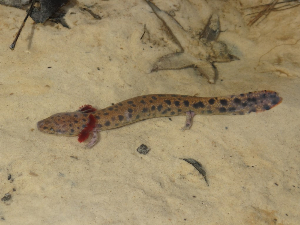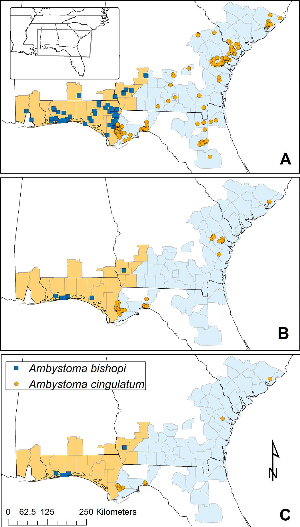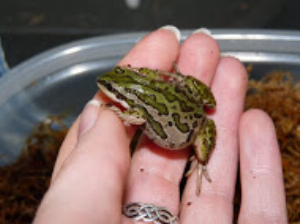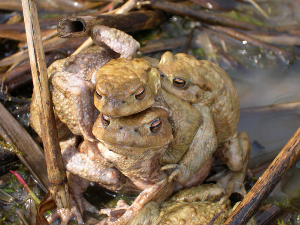Search ARMI Database
Search term(s)
Contribution Number
Search Results
874 record(s) found.
Papers & Reports Evaluating within-population variability in behavior and demography for the adaptive potential of a dispersal-limited species to climate change.
Authors: David J Muñoz; K M Hesed; Evan HC Grant; David AW Miller
Date: 2016-11-17 | Outlet: Ecology and Evolution
Multiple pathways exist for species to respond to changing climates. However, responses of dispersal-limited species will be more strongly tied to ability to adapt within existing populations as rates of environmental change will likely exceed movement rates. Here, we assess adaptive capacity in Plethodon cinereus, a dispersal-limited woodland salamander. We quantify plasticity in behavior and variation in demography to observed variation in environmental variables over a 5 year period. We found strong evidence that temperature and rainfall influence P. cinereus surface presence, indicating changes in climate are likely to affect seasonal activity patterns. We also found that warmer summer temperatures reduced individual growth rates into the autumn, which is likely to have negative demographic consequences. Reduced growth rates may delay reproductive maturity and lead to reductions in size-specific fecundity, potentially reducing population level persistence. To better understand within-population variability in responses, we examined differences between two common color morphs. Previous evidence suggests that the color polymorphism may be linked to physiological differences in heat and moisture tolerance. We found only moderate support for morph-specific differences for the relationship between individual growth and temperature. Measuring environmental sensitivity to climatic variability is the first step in predicting species’ responses to climate change. Our results suggest phenological shifts and changes in growth rates are likely responses under scenarios where further warming occurs, and we discuss possible adaptive strategies for resulting selective pressures.  
Papers & Reports Amphibian conservation: clarifications to comments from Andreone
Authors: Erin Muths; Robert N Fisher
Date: 2017
We appreciate the review and comments from Andreone (2016) regarding our proposed alternative strategy for addressing the amphibian crisis. Andreone recognizes the utility of an incident command system approach but doubts the feasibility of implementation at an international level. We stated in our original article, however, that ‘The feasibility of our suggestion is debatable, but our point is that radically different approaches are necessary to effectively manage the largest extinction event in modern history’
Papers & Reports SURGICAL TECHNIQUE FOR THE PLACEMENT OF INTRACOELOMIC RADIO TRANSMITTERS AND EXTERNAL SILICONE PASSIVE SAMPLING DEVICES FOR NORTHERN LEOPARD FROGS (Lithobates pipiens )
Authors: T Yaw; J E Swanson; Clay L Pierce; Erin Muths; Kelly L Smalling; M Vandever; B A Zaffarano
Date: 2017 | Outlet: Journal of Herpetological Medicine and Surgery
Amphibians are excellent sentinels for contaminant exposure in prairie wetlands. Development of passive sampling devices (PSD) has greatly improved in recent years, and they present an innovative sampling technology that can potentially yield individual-specific, quantifiable data on chemical exposure. In this study, PSDs were attached to the ventral skin of 20 northern leopard frogs (Lithobates pipiens) with polypropylene sutures after radio transmitters had been surgically inserted into the coleomic cavity. After a recovery period frogs were released into the wild and located daily using radio telemetry to assess how long PSDs would remain attached in the frogs’ natural habitat. After one week, PSDs remained on 18 of the original 20 frogs. At 2 weeks 16 frogs were recovered and no PSDs remained attached. Although valuable data can be obtained over a short time period, more research will be necessary to demonstrate effectiveness of externally attaching silicone PSDs to northern leopard frogs for time periods longer than 1-2 weeks.
Papers & Reports RARE ALLUVIAL SANDS OF EL MONTE VALLEY, CALIFORNIA (SAN DIEGO COUNTY) SUPPORT HIGH HERPETOFAUNAL SPECIES RICHNESS AND DIVERSITY, DESPITE SEVERE HABITAT DISTURBANCE
Authors: Jonathan Q Richmond; Carlton J Rochester; N W Smith; J A Nordland; Robert N Fisher
Date: 2016 | Outlet: Southwest Naturalist 61:294-306
We characterized the species richness, diversity and distribution of amphibians and reptiles inhabiting El Monte Valley, a heavily disturbed, alluvium-filled basin within the lower San Diego River in Lakeside, California. This rare habitat type in coastal southern California is designated as a critical sand resource by the State of California (California Geological Survey) and is currently under consideration for a large-scale sand mining operation with subsequent habitat restoration. We conducted field surveys in the valley from June 2015-May 2016 and placed emphasis on detecting the coastal form of the California glossy snake (Arizona elegans occidentalis) given its status as a species of special concern by the California Department of Fish and Wildlife, its preference for sandy/gravelly habitats, and its documented historical presence in the valley. Survey techniques included drift fence lines with funnel traps, cover board arrays, walking transects, and road driving. We recorded 1,208 total captures in five sampling sections extending across the valley floor, revealing high species richness and diversity but with marked unevenness in species’ abundances. Two species are covered in the San Diego Multiple Species Conservation Program and 10 are listed as species of special concern in California. Snakes were the most species rich taxonomic group (13 species representing 11 genera), followed by lizards (11 species representing nine genera). Next to the southern Pacific rattlesnake (Crotalus oreganus helleri), A. e. occidentalis was the second most frequently detected snake species (n = 23 captures). Amphibian species richness was limited to two species of toad and one frog. Despite the relatively limited 12-month sampling period, a longstanding drought, and severe habitat disturbance, our study demonstrates that El Monte Valley harbors a rich herpetofauna that includes a number of sensitive species, including the largest known concentration of A. e. occidentalis in coastal San Diego County.
Papers & Reports Overcoming Roadblocks to Recovery of Declining Amphibian Populations in the United States
Authors: Susan C Walls; Lianne Ball; William J Barichivich; K M Enge; Thomas A Gorman; J G Palis; Raymond D Semlitsch; Kenneth C Dodd; Katherine M O'Donnell
Date: 2016-12-09 | Outlet: BioScience 67(2):156-165.
The U.S. Endangered Species Act of 1973 (ESA) affords many potential benefits to species threatened with extinction. Yet, most at-risk amphibians – one of the most imperiled vertebrate groups – remain unlisted under provisions of the ESA, and many impediments to recovery exist for those species that have been listed. Of the 35 U.S. amphibian species and distinct population segments (DPS) listed under the ESA, 28.6% currently lack a final (completed) recovery plan, 40% lack designated critical habitat, and 8.5% lack both. For species/DPS that have recovery plans, time between listing and development of those plans was from 2 to 29 years, and the time between listing and designation of critical habitat ranged from 0 to 14 years. The underlying causes of such delays in protection are complex and constitute roadblocks to recovery of imperiled species. We outline a series of strategic actions by which these roadblocks may be overcome.
Papers & Reports Amphibian dynamics in constructed ponds on a wildlife refuge: developing expected responses to hydrological restoration
Authors: Blake R Hossack
Date: 2016 | Outlet: Hydrobiologia
Management actions are based upon predictable responses. To form expected responses to restoration actions, I estimated habitat relationships and trends (2002‒2015) for four pond-breeding amphibians on a wildlife refuge (Montana, USA) where changes to restore historical hydrology to the system greatly expanded (≥8 times) the flooded area of the primary breeding site for western toads (Anaxyrus boreas). Additional restoration actions are planned for the near future, including removing ponds that provide amphibian habitat. Multi-season occupancy models based on data from 15 ponds sampled during 7 years revealed that the number of breeding subpopulations increased modestly for Columbia spotted frogs (Rana luteiventris) and was stationary for long-toed salamanders (Ambystoma macrodactylum) and Pacific treefrogs (Pseudacris regilla). For these three species, pond depth was the characteristic that was associated most frequently with occupancy or changes in colonization and extinction. In contrast, a large decrease in colonization by western toads explained the decline from eight occupied ponds in 2002 to two ponds in 2015. This decline occurred despite an increase in wetland area and the colonization of a newly-created pond. These changes highlight the challenges of managing for multiple species and how management responses can be unpredictable, possibly reducing the efficacy of targeted actions.
Papers & Reports Large-scale recovery of an endangered amphibian despite ongoing exposure to multiple stressors
Authors: Roland A Knapp; Gary M Fellers; Patrick M Kleeman; David AW Miller; V T Vredenburg; Erica B Rosenblum; Cheryl J Briggs
Date: 2016-10-03 | Outlet: Proceedings of the National Academy of Sciences, doi: 10.1073/pnas.1600983113
Amphibians are one of the most threatened animal groups, with 32% of species at risk of extinction. Given this, is the disappearance of a large fraction of the Earth’s amphibians inevitable, or are some declining species more resilient than is generally assumed? We address this question in a species that is emblematic of many declining amphibians, the endangered Sierra Nevada yellow-legged frog (Rana sierrae). Based on >7,000 frog surveys conducted across Yosemite National Park over a 20-year period, we show that after decades of decline and despite ongoing exposure to multiple stressors including introduced fish, the recently emerged disease chytridiomycosis, and pesticides, R. sierrae abundance increased 7-fold during the study and at a rate of 11% per year. These increases occurred in hundreds of populations throughout Yosemite, providing a rare example of amphibian recovery at an ecologically relevant spatial scale. Results from a laboratory experiment indicate that these increases may be due in part to reduced frog susceptibility to chytridiomycosis. The disappearance of nonnative fish from numerous water bodies following cessation of stocking also contributed to the recovery. The large-scale increases in R. sierrae abundance we document suggest that when habitats are relatively intact and stressors are reduced in their importance by active management or species’ adaptive responses declines of some amphibian may be partially reversible, at least at a regional scale. Other studies conducted over similarly large temporal and spatial scales are critically needed to provide insight and generality about the reversibility of amphibian declines at a global scale.
Papers & Reports Estimating occurrence and detection probabilities for stream-breeding salamanders in the Gulf Coastal Plain
Authors: J Y Lamb; Hardin J Waddle; C P Qualls
Date: 2017-03 | Outlet: Journal of Herpetology 51:102-108
Large gaps exist in our knowledge of the ecology of stream-breeding plethodontid salamanders in the Gulf Coastal Plain. Data describing where these salamanders are likely to occur along environmental gradients, as well as their likelihood of detection, are important for the prevention and management of amphibian declines. We used presence/absence data from leaf litter bag surveys and a hierarchical Bayesian multispecies single-season occupancy model to estimate the occurrence of five species of plethodontids across reaches in headwater streams in the Gulf Coastal Plain. Average detection probabilities were high (range = 0.432-0.942) and unaffected by sampling covariates specific to the use of litter bags (i. e., bag submergence, sampling season, in-stream cover). Estimates of occurrence probabilities differed substantially between species (range = 0.092-0.703) and were influenced by the size of the upstream drainage area and by the maximum proportion of the reach that dried. The effects of these two factors were not equivalent across species. Our results demonstrate that hierarchical multispecies models successfully estimate occurrence parameters for both rare and common streambreeding plethodontids. The resulting models clarify how species are distributed within stream networks, and they provide baseline values that will be useful in evaluating the conservation statuses of plethodontid species within lotic systems in the Gulf Coastal Plain.
Papers & Reports Life history plasticity does not confer resilience to environmental change in the mole salamander (Ambystoma talpoideum)
Authors: Courtney L Davis; David AW Miller; Susan C Walls; William J Barichivich; Jeffrey W Riley; Mary E Brown
Date: 2017-03 | Outlet: Oecologia 183(3):739-749.
Plasticity in life history strategies can be advantageous for species that occupy spatially or temporally variable environments. We examined how phenotypic plasticity influences responses of the mole salamander, Ambystoma talpoideum, to disturbance events at the St. Marks National Wildlife Refuge (SMNWR), FL, USA from 2009 to 2014. We observed periods of extensive drought early in the study, in contrast to high rainfall and expansive flooding events in later years. Flooding facilitated colonization of predatory fishes to isolated wetlands across the refuge. We employed multistate occupancy models to determine how this natural experiment influenced the occurrence of aquatic larvae and paedomorphic adults and what implications this may have for the population. We found that, in terms of occurrence, responses to environmental variation differed between larvae and paedomorphs, but plasticity (i.e. the ability to metamorphose rather than remain in the aquatic environment) was not sufficient to buffer populations from declining as a result of environmental perturbations. Drought and fish presence negatively influenced occurrence dynamics of larval and paedomorphic mole salamanders and, consequently, contributed to observed short-term declines of this species. Overall occurrence of larval salamanders decreased from https://0.611 in 2009 to https://0.075 in 2014 and paedomorph occurrence decreased from https://0.311 in 2009 to https://0.121 in 2014. Although variation in selection pressures has likely maintained this polyphenism previously, our results suggest that continued changes in environmental variability and the persistence of fish in isolated wetlands could lead to a loss of paedomorphosis in the SMNWR population and, ultimately, impact regional persistence in the future.
Papers & Reports Extinction Debt as a Driver of Amphibian Declines: an Example with Imperiled Flatwoods Salamanders
Authors: Raymond D Semlitsch; Susan C Walls; William J Barichivich; Katherine M O'Donnell
Date: 2017-01-11 | Outlet: Journal of Herpetology 51(1):12-18.
A comprehensive view of population declines and their underlying causes is necessary to reverse species’ loss. Historically, in many cases, a narrow view may have allowed species’ declines to continue, virtually undetected, for long periods of time (perhaps even decades). We suggest that extinction debt is likely responsible for numerous (and perhaps most) amphibian declines and that this perspective should be incorporated into the structure of amphibian research and management. Extinction debt, originally proposed to explain changes in species richness following environmental disturbance, may also refer to the proportion of populations of an individual species that is expected to eventually be lost due to habitat change. A conservation framework to address extinction debt focuses research on threats at the individual, population, and metapopulation levels. This approach will help enhance, restore, and protect specific processes and habitats at the proper scale by directing management to the most vulnerable level and stage of a species. We illustrate this approach using Flatwoods Salamanders, Ambystoma cingulatum and Ambystoma bishopi, which occurred historically throughout the Coastal Plain of the southeastern USA but have experienced a > 85% loss of populations in recent years. Reversal of these losses is possible only if conservation and recovery efforts encompass individual, population, and metapopulation levels. We illustrate our framework by outlining actions that could be taken at each of these levels to help guide conservation and management of amphibians with complex life cycles.
Papers & Reports Species interactions and the effects of climate variability on a wetland amphibian metacommunity
Authors: Courtney L Davis; David AW Miller; Susan C Walls; William J Barichivich; Jeffrey W Riley; Mary E Brown
Date: 2016-10-02 | Outlet: Ecological Applications 27(1):285-296.
Disentangling the role that multiple interacting factors have on species responses to shifting climate poses a significant challenge. However, our ability to do so is of utmost importance to predict the effects of climate change on species distributions. We examined how populations of three species of wetland breeding amphibians, which varied in life history requirements, responded to a six-year period of extremely variable in precipitation. This interval was punctuated by both extensive drought and heavy precipitation and flooding, providing a natural experiment to measure community responses to environmental perturbations. We estimated occurrence dynamics using a discrete hidden Markov modeling approach that incorporated information regarding habitat state and predator-prey interactions. This approach allowed us to measure how metapopulation dynamics of each amphibian species was affected by interactions among weather, wetland hydroperiod, and co-occurrence with fish predators. The pig frog, a generalist, proved most resistant to perturbations, with both colonization and persistence being unaffected by seasonal variation in precipitation or co-occurrence with fishes. The ornate chorus frog, an ephemeral wetland specialist, responded positively to periods of drought owing to increased persistence and colonization rates during periods of low-rainfall. Low probabilities of occurrence of the ornate chorus frog in long-duration wetlands were driven by interactions with predators due to low colonization rates when fishes were present. The mole salamander was most sensitive to shifts in water availability. In our study area, this species never occurred in short-duration wetlands and persistence probabilities decreased during periods of drought. At the same time, negative effects occurred with extreme precipitation because flooding facilitated colonization of fishes to isolated wetlands and mole salamanders did not colonize wetlands once fishes were present. We demonstrate that the effects of changes in water availability depend on interactions with predators and wetland type and are influenced by the life history of each of our species. The dynamic species occurrence modeling approach we used offers promise for other systems when the goal is to disentangle the complex interactions that determine species responses to environmental variability.
Papers & Reports Influence of climate drivers on colonization and extinction
Authors: Andrew M Ray; W R Gould; Blake R Hossack; A Sepulveda; D Thoma; Debra A Patla; R Daley; Robert Al-Chokhachy
Date: 2016 | Outlet: Ecosphere 7:1-21
Freshwater wetlands are particularly vulnerable to climate change. Specifically, changes in
temperature, precipitation, and evapotranspiration (i.e., climate drivers) are likely to alter flooding regimes of wetlands and affect the vital rates, abundance, and distributions of wetland-dependent species. Amphibians may be among the most climate-sensitive wetland-dependent groups as many species rely on shallow or intermittently flooded wetland habitats for breeding. Here, we integrated multiple years of high-resolution gridded climate and amphibian monitoring data from Grand Teton and Yellowstone National Parks to explicitly model how variations in climate drivers and habitat conditions affect the occurrence and breeding dynamics (i.e., annual extinction and colonization rates) of amphibians. Our results showed that models incorporating climate drivers outperformed models of amphibian breeding dynamics that were exclusively habitat based. Moreover, climate-driven variation in extinction rates, but not colonization rates, disproportionately influenced amphibian occupancy in monitored wetlands. Long-term monitoring from national parks coupled with high-resolution climate data sets will be crucial to describing population dynamics and characterizing the sensitivity of amphibians and other wetland-dependent species to climate change. Further, long-term monitoring of wetlands in national parks will help reduce uncertainty
surrounding wetland resources and strengthen opportunities to make informed, science-based
decisions that have far-reaching benefits.
temperature, precipitation, and evapotranspiration (i.e., climate drivers) are likely to alter flooding regimes of wetlands and affect the vital rates, abundance, and distributions of wetland-dependent species. Amphibians may be among the most climate-sensitive wetland-dependent groups as many species rely on shallow or intermittently flooded wetland habitats for breeding. Here, we integrated multiple years of high-resolution gridded climate and amphibian monitoring data from Grand Teton and Yellowstone National Parks to explicitly model how variations in climate drivers and habitat conditions affect the occurrence and breeding dynamics (i.e., annual extinction and colonization rates) of amphibians. Our results showed that models incorporating climate drivers outperformed models of amphibian breeding dynamics that were exclusively habitat based. Moreover, climate-driven variation in extinction rates, but not colonization rates, disproportionately influenced amphibian occupancy in monitored wetlands. Long-term monitoring from national parks coupled with high-resolution climate data sets will be crucial to describing population dynamics and characterizing the sensitivity of amphibians and other wetland-dependent species to climate change. Further, long-term monitoring of wetlands in national parks will help reduce uncertainty
surrounding wetland resources and strengthen opportunities to make informed, science-based
decisions that have far-reaching benefits.
Papers & Reports Survival estimates for reintroduced populations of the Chiricahua Leopard Frog (Lithobates chiricahuensis)
Authors: P E Howell; Blake R Hossack; Erin Muths; Brent H Sigafus; Richard Chandler
Date: 2016 | Outlet: Copeia. 104.4: 824-830.
Global amphibian declines have been attributed to a number of factors including disease, invasive species, habitat degradation, and climate change. Reintroduction is one management action that is commonly used with the goal of recovering imperiled species. The success of reintroductions varies widely and evaluating their efficacy requires estimates of population viability metrics, such as underlying vital rates and trends in abundance. Although rarely quantified, assessing vital rates for recovering populations provides a more mechanistic understanding of population growth than numerical trends in population occupancy or abundance. We used three years of capture-mark-recapture data from three breeding ponds and a Cormack-Jolly-Seber model to estimate annual apparent survival for reintroduced populations of the federally-threatened Chiricahua Leopard Frog (Lithobates chiricahuensis) at the Buenos Aires National Wildlife Refuge (BANWR), in the Altar Valley, Arizona, USA. To place our results in context, we also compiled published survival estimates for other ranids. Average apparent survival of Chiricahua Leopard Frogs at BANWR was https://0.27 (95% CI [https://0.07, 0.74]) and average individual capture probability was https://0.02 (95% CI [0, 0.05]). Our apparent survival estimate for Chiricahua Leopard Frogs is lower than for most other ranids, and is not consistent with recent research that showed metapopulation viability in the Altar Valley is high. We suggest that low apparent survival may be indicative of high emigration rates. We recommend that future research should estimate emigration rates so that actual, rather than apparent, survival can be quantified to improve population viability assessments of threatened species following reintroduction efforts.
Papers & Reports Phenotypic plasticity in developmental rate is insufficient to offset high tadpole mortality in rapidly drying ponds
Authors: Staci M Amburgey; M A Murphy; W C Funk
Date: 2016-06 | Outlet: Ecosphere 2016, 00(00):e01386. 10.1002/ecs2.1386
Habitat suitability is strongly regulated by seasonal conditions and stochastic processes, and
this is especially important in temporary aquatic systems that contain organisms with complex life cycles.
We investigated the potential for phenotypic plasticity in timing of and size at metamorphosis to mitigate
effects of altered habitat conditions, specifically shortened hydroperiod (duration of water in ponds)
and altered predator-prey dynamics, in the pond-breeding boreal chorus frog (Pseudacris maculata). We
simulated reduced hydroperiod and concentrated predator cue in the laboratory to understand potential
benefits and costs of plasticity. Tadpoles developed faster in response to the combined effects of reduced
hydroperiod and increased concentration of predator cue, potentially due to reduced conspecific density.
In contrast, there was no effect of reduced hydroperiod or predator cue on size at metamorphosis. Alone,
this result suggests that phenotypic plasticity may allow P. maculata to escape the negative effects of rapidly
drying ponds. However, tadpole survival was significantly lower in reduced hydroperiod treatments
relative to all other treatments, suggesting that even if plasticity acts as a buffer against reduced hydroperiod
by facilitating metamorphosis, heightened mortality may offset benefits of this rapid response. Our
results add to previous studies of plastic responses in amphibians by disentangling the costs and benefits
of plasticity in habitats with multiple, simultaneous stressors. We show that while plasticity may accelerate
metamorphosis, similar, heightened levels of mortality are experienced regardless of plasticity. This
implies that plasticity may not completely buffer populations against the effects of altered habitat conditions,
such as those that occur with climate change or urbanization.
this is especially important in temporary aquatic systems that contain organisms with complex life cycles.
We investigated the potential for phenotypic plasticity in timing of and size at metamorphosis to mitigate
effects of altered habitat conditions, specifically shortened hydroperiod (duration of water in ponds)
and altered predator-prey dynamics, in the pond-breeding boreal chorus frog (Pseudacris maculata). We
simulated reduced hydroperiod and concentrated predator cue in the laboratory to understand potential
benefits and costs of plasticity. Tadpoles developed faster in response to the combined effects of reduced
hydroperiod and increased concentration of predator cue, potentially due to reduced conspecific density.
In contrast, there was no effect of reduced hydroperiod or predator cue on size at metamorphosis. Alone,
this result suggests that phenotypic plasticity may allow P. maculata to escape the negative effects of rapidly
drying ponds. However, tadpole survival was significantly lower in reduced hydroperiod treatments
relative to all other treatments, suggesting that even if plasticity acts as a buffer against reduced hydroperiod
by facilitating metamorphosis, heightened mortality may offset benefits of this rapid response. Our
results add to previous studies of plastic responses in amphibians by disentangling the costs and benefits
of plasticity in habitats with multiple, simultaneous stressors. We show that while plasticity may accelerate
metamorphosis, similar, heightened levels of mortality are experienced regardless of plasticity. This
implies that plasticity may not completely buffer populations against the effects of altered habitat conditions,
such as those that occur with climate change or urbanization.
Papers & Reports Mitigating amphibian chytridiomycosis in nature
Authors: T WJ Garner; Benedikt R Schmidt; An Martel; Frank Pasmans; Erin Muths; A C Cunningham; C Weldon; Matthew C Fisher; Jaime Bosch
Date: 2016-10 | Outlet: Phil. Trans.R.Soc.B 371: 20160207. dx.doi.org/10.1098/rstb.2016.0207
Amphibians across the planet face the threat of population decline and extirpation caused by the disease chytridiomycosis. Despite consensus that the fungal pathogens responsible for the disease are conservation issues, strategies to mitigate their impacts in the natural world are, at best, nascent. Reducing risk associated with the movement of amphibians, non-amphibian vectors and other sources of infection remains the first line of defence and a primary objective when mitigating the threat of disease in wildlife. Amphibian-associated chytridiomycete fungi and chytridiomycosis are already widespread, though, and in this article we discuss options for mitigating the threats once disease emergence has occurred in wild amphibian populations.
Papers & Reports Using spatial capture-recapture to elucidate population processes and space-use in herpetological studies
Authors: David J Muñoz; David AW Miller; C Sutherland; Evan HC Grant
Outlet: Journal of Herpetology xx:xxx-xxx
Papers & Reports INFORMING RECOVERY OF THE ENDANGERED SONORAN TIGER SALAMANDER: 10-YEAR TRENDS IN OCCUPANCY OF SALAMANDERS, INVASIVE PREDATORS, AND THEIR CO-OCCURRENCE
Authors: Blake R Hossack; R K Honeycutt; Thierry C Chambert; Brent H Sigafus; T R Jones,; J A Sorensen; James C Rorabaugh; Erin Muths
Outlet: Unpublished Report (see https://doi.org/10.1016/j.biocon.2017.03.004)
The Sonoran Tiger Salamander (Ambystoma mavortium stebbinsi) occurs in a single valley that spans the USA-Mexico border and was listed as federally-endangered in 1997. The listing was driven by a variety of threats, including small geographic range and threats from invasive predators. The recovery plan for this subspecies requires scientifically-credible estimates of changes in occurrence of the Sonoran Tiger Salamander and invasive predators before further evaluation of the listing status. The recent completion of a 10-year (2004–2013) monitoring program, coordinated by the Arizona Game and Fish Department and the U.S. Fish and Wildlife Service, generated data sufficient to estimate (1) trends in breeding site occupancy by the Sonoran Tiger Salamander, (2) trends in occupancy of introduced predators, and (3) probability of co-occurrence between Sonoran Tiger Salamanders and invasive predators. We used Bayesian hierarchical models to estimate annual probabilities of occupancy and co-occurrence, after adjusting for imperfect detection. Our analyses showed that pond-level occupancy of Sonoran Tiger Salamanders increased by an estimated 2.2% (95% credible interval [CI] = 0.4%–3.8%) per year. Occupancy of invasive predators decreased by an estimated 0.7% (95% CI = −2.4%–0.7%) per year. In ponds with water, presence of invasive predators reduced salamander occupancy by 23.01% (95% CI = 8.72–43.73) across the 10-yr monitoring program. These results will assist in evaluating the status of the Sonoran Tiger Salamander and prioritizing management actions that are supported by defensible estimates.
Papers & Reports Climate-mediated competition in a high-elevation salamander community
Authors: E A Dallalio; Adrianne B Brand; Evan HC Grant
Outlet: Journal of Herpetology xx:xxx-xxx
The distribution of the federally endangered Shenandoah salamander (Plethodon shenandoah) is presumed to be limited by competition with the red-backed salamander (Plethodon cinereus). In particular, the current distribution of P. shenandoah is believed to be restricted to warmer and drier habitats because of interspecific interactions. These habitats may be particularly sensitive to climate change, though the influence of competition may also be sensitive to temperature and relative humidity. We investigated the response of P. shenandoah to competition with P. cinereus under four climate scenarios in 3-dimensional mesocosms. The results suggest that although climate change may alleviate competitive pressure from P. cinereus, warmer temperatures may also significantly influence the persistence of the species across its known range.
Papers & Reports Potential Interactions Among Disease, Pesticides, Water Quality and Adjacent Land Cover in Amphibian Habitats in the United States
Authors: William A Battaglin; Kelly L Smalling; Chauncey W Anderson; Daniel L Calhoun; T Chestnut; Erin Muths
Date: 2016-05-24 | Outlet: Science of the Total Environment 320-332
To investigate interactions among disease, pesticides, water quality and adjacent land cover we collected samples of water, sediment, and frog tissue from 21 sites in 7 States in the United States (US) representing a variety of amphibian habitats. All samples were analyzed for > 90 pesticides and pesticide degradates, and water and frogs were screened for the amphibian chytrid fungus Batrachochytrium dendrobatidis (Bd) using molecular methods. Pesticides and pesticide degradates were detected frequently in frog breeding habitats (water and sediment) as well as in frog tissue. Fungicides occurred more frequently in water, sediment, and tissue than was expected based upon their limited use relative to herbicides or insecticides. Pesticide occurrence in water or sediment was not a strong predictor of occurrence in tissue, but pesticide concentrations in tissue were correlated positively to agricultural and urban land, and negatively to forested land in 2-kilometer buffers around the sites. Bd was detected in water at 45% of sites, and on 34% of swabbed frogs. Bd detections in water were not associated with differences in land use around sites, but sites with detections had colder water. Frogs that tested positive for Bd were associated with sites that had higher total fungicide concentrations in water and sediment, but lower insecticide concentrations in sediments relative to frogs that were Bd negative. Bd concentrations on frog swabs were positively correlated to dissolved organic carbon, and total nitrogen and phosphorus, and negatively correlated to pH and water temperature.
Data were collected from a range of locations and amphibian habitats and represent some of the first field-collected information aimed at understanding the interactions between pesticides, land use, and amphibian disease. These interactions are of particular interest to conservation efforts as many amphibians live in altered habitats and may depend on wetlands embedded in these landscapes to survive.
Data were collected from a range of locations and amphibian habitats and represent some of the first field-collected information aimed at understanding the interactions between pesticides, land use, and amphibian disease. These interactions are of particular interest to conservation efforts as many amphibians live in altered habitats and may depend on wetlands embedded in these landscapes to survive.
Papers & Reports First Estimates of the Probability of Survival in a Small-bodied, High Elevation Frog or, how Historical Data Can Be Useful
Authors: Erin Muths; R Scherer; Staci M Amburgey; T Matthews; A Spencer; P. Stephen Corn
Date: 2016-06 | Outlet: Canadian Journal of Zoology, doi: 10.1139/cjz-2016-0024
In an era of shrinking budgets yet increasing demands for conservation, the value of existing (i.e., historical) data is elevated. Lengthy time-series on common, or previously common, species are particularly valuable and may be available only through the use of historical information. We provide first estimates of the probability of survival and longevity (https://0.67-0.79; 5-7 yr) for a subalpine population of a small-bodied, ostensibly common amphibian, the boreal chorus frog, using historical data and contemporary, hypothesis-driven information-theoretic analyses. We also test a priori hypotheses about the effects of color morph (as suggested by early reports) and of drought (as suggested by recent climate predictions on survival). Using robust mark-recapture models, we find some support for early hypotheses regarding the effect of color on survival, but we find no effect of drought. The congruence between early findings and our analyses highlights the usefulness of historical information by providing raw data for contemporary analyses and context for conservation and management decisions.






